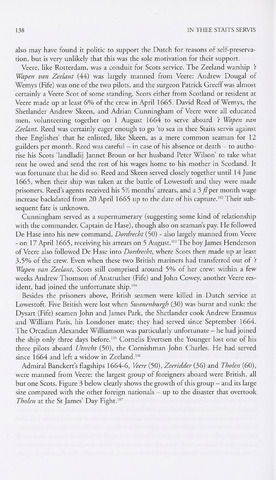138
IN THEE STATES SERVIS
also may have found it politic to support the Dutch for reasons of self-preserva
tion, but is very unlikely that this was the sole motivation for their support.
Veere, like Rotterdam, was a conduit for Scots service. The Zeeland warship 't
Wapen van Zeelant (44) was largely manned from Veere: Andrew Dougal of
Wemys (Fife) was one of the two pilots, and the surgeon Patrick Greeff was almost
certainly a Veere Scot of some standing. Scots either from Scotland or resident at
Veere made up at least 6% of the crew in April 1665. David Reed of Wemys, the
Shetlander Andrew Skeen, and Adrian Cunningham of Veere were all educated
men, volunteering together on 1 August 1664 to serve aboard 't Wapen van
Zeelant. Reed was certainly eager enough to go 'to sea in thee Staits servis against
thee Englishes' that he enlisted, like Skeen, as a mere common seaman for 12
guilders per month. Reed was careful in case of his absence or death to autho
rise his Scots 'landladij Jannet Broun or her husband Peter Wilson' to take what
rent he owed and send the rest of his wages home to his mother in Scotland. It
was fortunate that he did so. Reed and Skeen served closely together until 14 June
1665, when their ship was taken at the battle of Lowestoft and they were made
prisoners. Reed's agents received his 51k months' arrears, and a 3 j?per month wage
increase backdated from 20 April 1665 up to the date of his capture.102 Their sub
sequent fate is unknown.
Cunningham served as a supernumerary (suggesting some kind of relationship
with the commander, Captain de Hase), though also on seaman's pay. He followed
De Hase into his new command, Dordrecht (50) - also largely manned from Veere
- on 17 April 1665, receiving his arrears on 5 August.103 The boy James Henderson
of Veere also followed De Hase into Dordrecht, where Scots then made up at least
3.5% of the crew. Even when these two British mariners had transferred out of't
Wapen van Zeelant, Scots still comprised around 5% of her crew: within a few
weeks Andrew Thomson of Anstruther (Fife) and John Cowey, another Veere res
ident, had joined the unfortunate ship.104
Besides the prisoners above, British seamen were killed in Dutch service at
Lowestoft. Five British were lost when Swanenburgh (30) was burnt and sunk: the
Dysart (Fife) seamen John and James Park, the Shetlander cook Andrew Erasmus
and William Paris, his Londoner mate; they had served since September 1664.
The Orcadian Alexander Williamson was particularly unfortunate - he had joined
the ship only three days before.105 Cornelis Evertsen the Younger lost one of his
three pilots aboard Utrecht (50), the Cornishman John Charles. He had served
since 1664 and left a widow in Zeeland.106
Admiral Banckert's flagships 1664-6, Veere (50), Zeeridder (36) and Tholen (60),
were manned from Veere: the largest group of foreigners aboard were British, all
but one Scots. Figure 3 below clearly shows the growth of this group and its large
size compared with the other foreign nationals up to the disaster that overtook
Tholen at the St James' Day Fight.107

